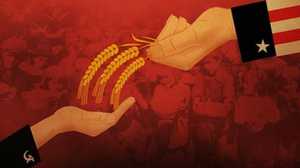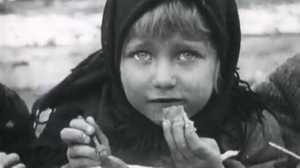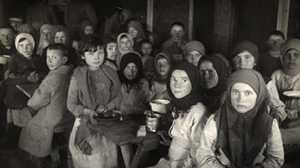United States Foreign Aid

October 22, 1914
Herbert Hoover creates the Commission for the Relief of Belgium (CRB) to organize relief efforts to combat a severe food shortage in German-occupied Belgium and Northern France during World War I.
The CRB will spend $80 million and dispense two billion pounds of grain and other food in the first year. The Commission will disband at the end of the war.
April 6, 1917
President Woodrow Wilson appoints Herbert Hoover as the head of the U.S. Food Administration, an organization providing food for the United States Army and its allies. In this position, Hoover will organize and send food shipments to the millions of starving people affected by World War I.
1921 - 1923
The American Relief Administration (formerly the U.S. Food Administration) sends rations of white bread, corn grits, rice, milk, cocoa, and sugar to Russia, where civil war and a severe drought have caused a widespread famine that killed five million Russian and Soviet citizens.
March 11, 1941
President Franklin D. Roosevelt signs the Lend-Lease Act. The program provides aid to countries that have been victims of war, beginning with Britain and China. Supplies such as weapons, clothes, vehicles, and food totaling around $50 billion ship to U.S. allies.
November 9, 1943
Spearheaded by the United States, Great Britain, the Soviet Union and China, 44 nations form the United Nations Relief and Rehabilitation Administration (UNRRA) to provide relief in war-torn countries.
1946
The UNRRA distributes $4.5 billion of food and supplies to Europe, where World War II had shattered economies.
March 12, 1947
In a message to Congress, President Harry Truman presents what will become known as the Truman Doctrine. In it, he pledges U.S. support for any country threatened by communism. Following Truman's speech, Congress approves $400 million in military and economic aid to Greece and Turkey.
Many historians will consider this the start of the Cold War.
June 5, 1947
Secretary of State George C. Marshall outlines what will become known as the Marshall Plan, a post-World War II initiative to send $13 billion to help boost recovery and reconstruction in Europe.
By the end of the program in 1953, most participating countries' economies will be more robust than they were prior to the war.
June 28, 1948
President Truman approves a plan to fly food and gas in to West Berlin after the Soviets cut all surface traffic to the area. Over the 11 months, until the blockage is lifted on May 12, 1949, the U.S. will provide over two million tons of supplies. The effort is known as the Berlin Airlift.
June 1951
The United States sends grain to India, where floods, earthquakes and locust plagues cause India's harvest to go awry, and a severe famine to take over.
March 1, 1961
President John F. Kennedy announces the Peace Corps as a challenge for Americans "to serve their country in the cause of peace by living and working in developing countries."
In the following decades, the Peace Corps will expand, sending more than 200,000 Americans to 139 countries.
September 4, 1961
The Foreign Assistance Act is approved. The Act administers the United States economic assistance programs, separating military and non-military aid.
November 3, 1961
President Kennedy establishes the United States Agency for International Development (USAID), an agency that organizes United States foreign aid around the world.
In the years to come the USAID will provide humanitarian assistance to Sub-Saharan Africa, Asia, Latin America, the Caribbean, Europe, Eurasia and the Middle East.
August 1, 1971
Bob Dylan and George Harrison are among several artists performing at "The Concert for Bangladesh" at Madison Square Garden. The event raises money for Bangladesh, which had been ravaged by genocide, droughts and flooding leading to more than 26,000 deaths.
December 17, 1973
The Foreign Assistance Act undergoes substantial changes with a "New Directions" approach, which emphasizes that assistance of basic human needs, such as food, nutrition and healthcare come first when assisting a foreign country.
1984-85
A drought in Ethiopia leads to widespread famine and over 400,000 deaths.
On July 13, 1985, "Live Aid" a dual-venue concert in Philadelphia and London, starred Led Zepplin, Queen, Mick Jagger, Tina Turner, and Madonna. The concert raised $140 million towards fighting poverty and hunger in Africa.
1992
Ongoing civil war and drought cause famine in Somalia. The United States leads a humanitarian relief effort by lending troops and delivering supplies to the country.
1995
In North Korea, extreme flooding leads to famine that kills one million people. Over the next seven years the United States government will provide North Korea with $900 million of food and development aid.
December 26, 2004
An earthquake causing a tsunami strikes the coast of Sumatra, Indonesia killing over 230,000 people.
USAID sends relief packages to survivors of the tsunami in Indonesia, adding to the largest relief effort in history.
January 12, 2010
A 7.0 magnitude earthquake strikes Haiti, killing an estimated 316,000 people and displacing more than a million.
The following day a U.S. hospital ship leaves for Port-au-Prince offering specialized medical care for the survivors. USAID and the United States government pledge relief to Haiti with food, medicine and shelter supplies.
March 11, 2011
A tsunami devastates the eastern cost of Japan after a 9.0 magnitude earthquake strikes off the coast. North of Tokyo, the two-part natural disaster flattens entire towns and causes a serious nuclear incident.
As part of an international response to the crisis, the U.S. military delivers food, water, and fuel aid to the Japanese people, and USAID deploys a response team for the search and rescue effort as well as nuclear experts to assist with the radioactive cleanup.









